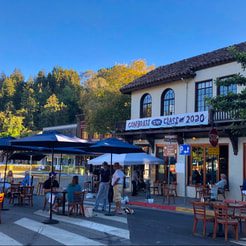Outdoor dining was banned as part of the state’s stay at home order (indoor dining shut down in November), they were forced to rely entirely on takeout and delivery throughout the holiday season and to operate at a tiny fraction of their usual operations. The nearly bare cupboard forced restaurant owners to vastly cut back on staff, again, and many employees had to turn to unemployment insurance – if they qualified.
Amidst it all, Marin restaurateurs created a petition, calling on Gov. Gavin Newsom and state Public Health Director Mark Ghaly to reconsider the ban on outdoor dining during the stay at home order, and asking Marin County Public Health Officer Dr. Matt Willis to allow outdoor dining once able to do so under state’s order. That petition garnered more than 6,300 signatures.
In lobbying on behalf of restaurants, the Mill Valley Chamber sought to achieve two primary goals: to keep the conversation alive about the lack of scientific data supporting an outdoor dining ban, and so that when Newsom ended the stay-at-home order – which he did out of the blue on Monday – restaurants could staff up and organize quickly with a bit of notice.
During the indoor dining shutdown, many Mill Valley restaurants had repurposed the space left unused space for indoor dining to spread out kitchen and prep staff and create more social distance between workers. “Our local restaurants are deeply committed to the health and safety of our customers, our employees and the entire Mill Valley community,” Piazza D’Angelo co-owner Felicia Ferguson says.
The Mill Valley City officials agreed, sending letters to Newsom and Ghaly, as well as Willis, asking for an exemption from the outdoor dining ban in lieu of data that says otherwise. The hunt for hard data on outdoor dining has been largely unsuccessful. Los Angeles County officials suffered a legal setback in November when a Superior Court judge found that county officials “acted arbitrarily” when deciding to close outdoor dining back in late November and that officials have a specific duty to “perform the required risk-benefit analysis” when making decisions about restaurant closures. The judge noted that County officials “could be expected to consider the economic cost of closing 30,000 restaurants, the impact to restaurant owners and their employees, and the psychological and emotional cost to a public tired of the pandemic.”
Separately, more than 50 restaurants, wineries and related businesses in Napa and Sonoma counties filed a lawsuit against Gov. Gavin Newsom in January, arguing the state’s restrictions on outdoor dining — while allowing other businesses like indoor retail and outdoor gyms to continue operating — violate the California Constitution’s equal protection clause and due process.
Marin Independent Journal columnist Dick Spotswood called on government agencies to rely more on science to justify shutdowns and bans on specific sectors, as did the Marin IJ editorial board. Eight professors at the University of California, San Francisco Division of Prevention Science chimed in that “some of the current restrictions are not evidence-based and little effort seems to have been made to justify them. This erodes trust.”
The City’s letters sparked a flurry of media coverage throughout the Bay Area, including the Marin IJ, KRON4, KTVU, SFGate, NBC Bay Area and Eater.
Marin could also see some additional good news in the coming weeks. All counties’ COVID-19 case counts and positive testing numbers are evaluated every week, and while Marin must remain in its current purple tier for a minimum of 3 weeks before being able to advance to the less restrictive red tier, it can move to a less restrictive tier if it attains a percent positivity rate between 5-8% for three weeks. Marin’s percent positivity rate on Jan. 22, the most recent day for which data is available, is 3.3%. MORE INFO ON THE TIER FRAMEWORK.

